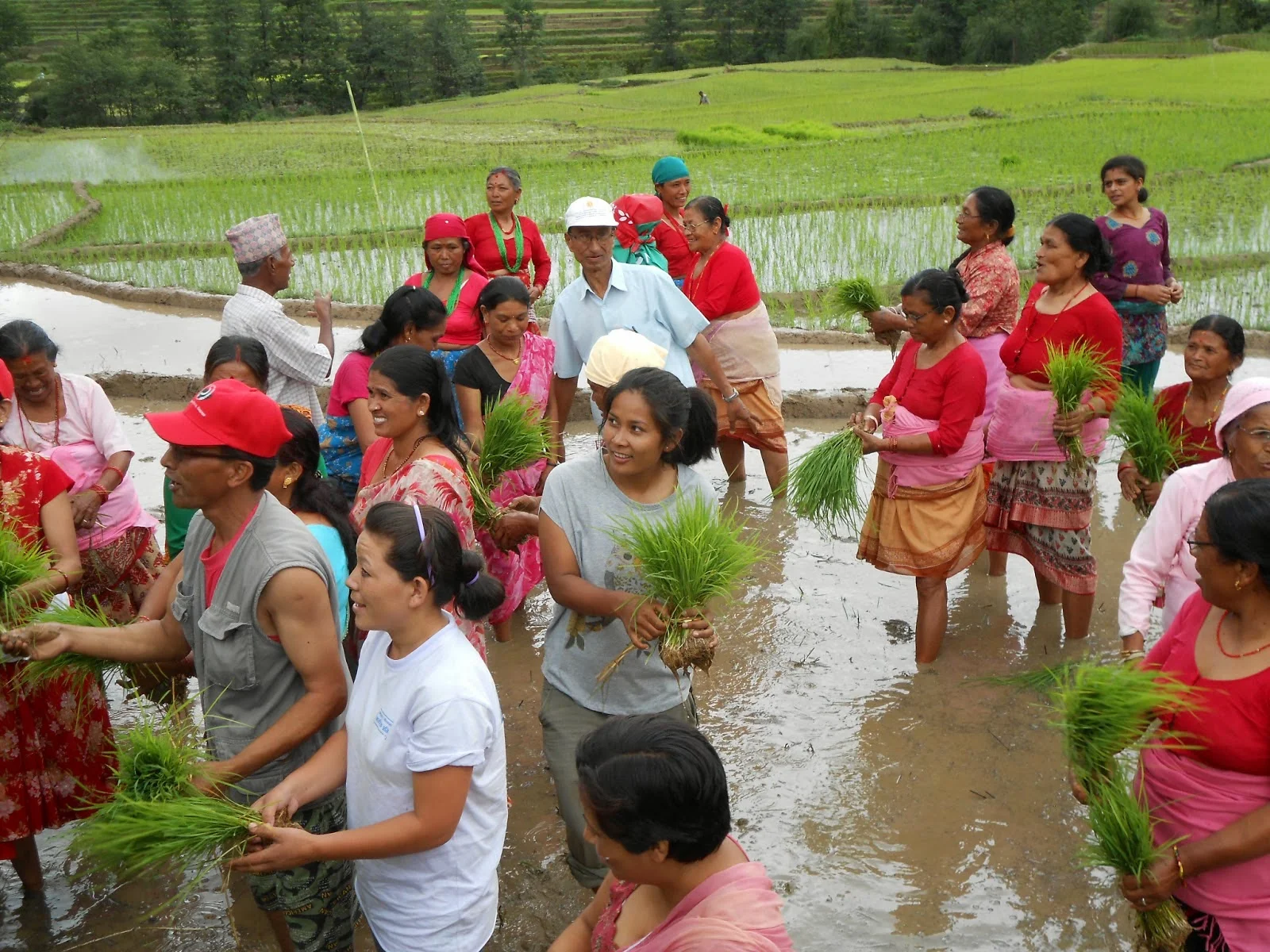Well, the paddy fields are green once again. The rains are pouring down dutifully most nights, and often in the evenings. A few women can be seen in the fields, completing unfinished business after the week before, when they, along with many other women, stood in ankle-deep muddy water planting fresh new saplings in the wet earth. Sometime before they took over the vast spaces, their menfolk were busy tilling the dry fields, leaving behind them long, neat rows of newly dug up earth.
Then came Ashad 15 (I think, July 30), the ‘National Paddy Day’ as declared by the government, also known as “Dahi-Chiura Khane Din” (day to eat curd and beaten rice). It’s an important date in the Nepali calendar, since the country’s populace is mostly involved in agriculture (more than seventy percent, I believe), and of course, everyone, but everyone, eats rice as their staple food in Nepal. There’s a phrase that has made its way onto most guide books on Nepal—“Daal, Bhaat, Tarkari”—that’s the national staple meal wherever you go in the country, something that our Nepali diaspora, those in the Western hemisphere, miss most oh so terribly!
For those still not familiar with the land of the Himalaya (there could be plenty; in my view, in countries with people who are not at all interested in knowing more about the world, even in this world of the internet, and of globalization, because they are so securely cocooned in the womb of their own countries), well, so just you know, daal is lentil soup, bhaat is steamed rice, and tarkari is a curry. The first and the last are accompaniments (but essential) while bhaat is what fills the stomach and sustains you through the day, packed as it is with rich energy giving carbohydrate.
Now, some of you know that Nepal may be a small country (though with a bigger population than many EU nation-states, and many times larger than its insignificantly tiny neighbor, Bhutan) but it has more than one hundred ethnicities and languages among its three regions: mountainous, hilly, and lowlands (terai). The elevation ranges from 70 meters above sea level in the terai, bordering India, to 8,848 meters above sea level (that’s the highest point on earth, by the way; for those mystified still, that’s Mount Everest!), and there’s a distance of just about 300 kilometers separating them. Meaning, you can be in the swelteringly hot terai one moment, and in minus many degrees arctic weather within a few hours. That’s Nepal for you!
Anyway, wherever you go in this really-not-so-small country, you are likely to find everyone eating “daal, bhaat, tarkari” for lunch and dinner, the two main meals of the day, and for many, the only two meals of the day. Well, yes, people generally are on the poorer side here, what with the Nepali rupee hardly worth anything against other currencies. Just think about it—a dollar is equal to more than a hundred rupees—is it any wonder, then, that we are poor? I mean, in this age of globalization, and so on.
Leaving such disconcerting subjects aside, let’s talk a bit more about rice, the food that sustains about 30 million Nepalis of all hues and colors and languages and cultures. I remember an eminent agronomist saying, “People eat what they grow, or people grow what they like to eat.” Well, in our case, both are one and the same, in my view. By the way, the man who said the above, a certain Wayne Freeman, a seed specialist in the Rockefeller Foundation’s Agricultural Program in India (1976-1982, or thereabouts), is also credited with introducing “Mansuli” rice to the country, which is undoubtedly the most commonly eaten type here. He describes “Mansuli” as having a nice taste and pleasant aroma.
The classes, however, go for the more exotic, and of course, many time more expensive, “Basmati” and such, but for the masses, it’s “Mansuli” all the way. Day and night, night and day, week after week, month after month, year after year, ad infinitum. Remembering that it’s some 30 million people we’re talking about (less one percent), and man, that’s a helluva lot rice, don’t you agree? So, do you now think it kind of unusual to have so much fanfare regarding the season of planting rice? There’s a name in Nepali for it, “Ropai”, which translates simply to “planting”. Now, there’s a lot more stuff that’s planted through the year, but this particular word is reserved only for the planting of rice. That’s how much importance rice holds in all Nepali hearts!

